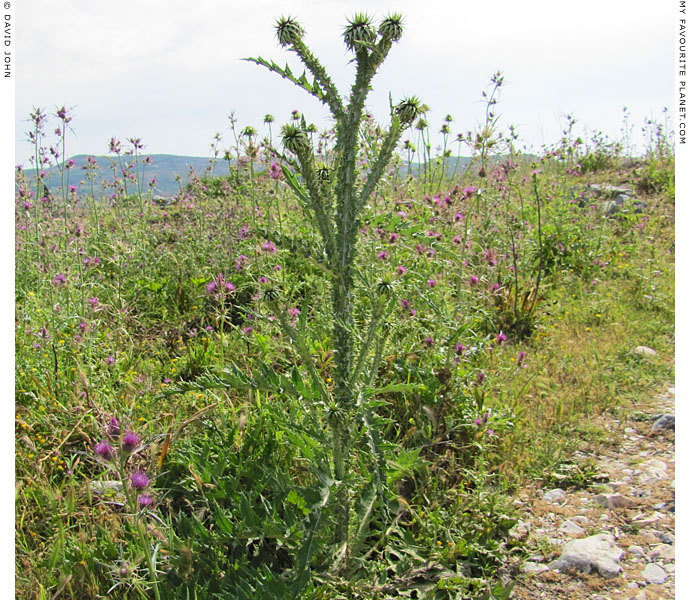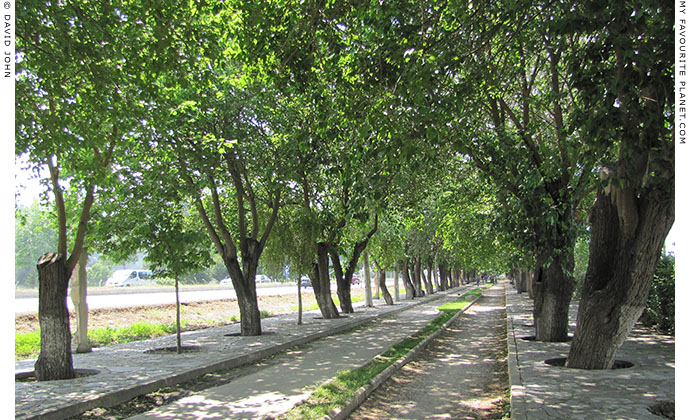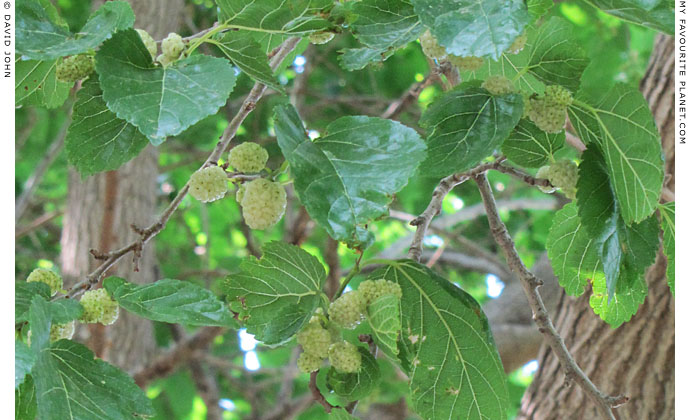|
|
 |
| My Favourite Planet > Blogs > Cheshire Cat Blog > 2013 |
 |
 |
back |
The Cheshire Cat Blog
 |
 |
25 May 2013 |
 |
| |
 |

Just some spring flowers growing out of a rock face on Güvercin Ada (Dove Island), Kusadasi.
Ionian Spring
Part 2 - Darling buds
Spring flowers, trees, fruit and other Aegean greenery in western Turkey. |
| |

Poppies, thistles and other plants compete for space at the archaeological site of Ephesus
|
Acres of bright red poppies are the most obvious visual sign that spring is gaining the upper hand around the Central Aegean region of Turkey. The cool, wet winter is almost over, and by the end of May many places will have seen their last rain until September.
Spring is therefore the best time of year to see the widest variety of plants and flowers in their prime. Turkey has an embarrassment of riches when it comes to what grows and can be grown, wild and cultivated, over a vast area with a great diversity of terrains, habitats and climates: from sub-tropical on the Black Sea coast to semi-desert at its eastern borders; mountains, valleys, plains, marshes, fields, meadows and forests.
The coastal area of Turkey's Central Aegean region is particularly green and rich in flora and fauna, and the countryside around Selçuk, which includes Ephesus, the House of the Virgin Mary and the old former Greek Village of Şirince, boasts a dizzying variety of vegetation. |
|
|
| |

Sageleaf rockrose (or sage-leaved cistus, Cistus salviifolius) with crickets in Ephesus
|
On most of the plants and flowers on this page there is some kind of insect crawling, feeding, hunting or just lounging around and soaking up the sun. Some of them are so tiny it's difficult to spot them with the naked eye, especially the Lilliputian ants.
The rich plant life attracts an enormous variety of creeping, crawling, wriggling, hopping and flying creatures, which in turn attract several species of birds, tortoises, lizards and amphibians (see Ionian spring part 3), as well as snakes, rodents and other small mammals. Everybody here is working on the food-chain-gang.
See another bug on a plant in part 3. |
|

Creepy crawlies explore a flower in Güzelçamlı |
|
| |

A starburst of common mallows (Malva sylvestris) in Ephesus |
| |

Never mind the hollyhocks! The Alcea rosea, or hollyhocks, in Ephesus
|
The genus Alcea rosea, of which there are 60 species, belong to the same family of Malvaceae (mallows) as the common mallow above.
At this point in the blog I have to admit that I am no expert on flowers, so I won't embarrass myself any further by trying to name all the beautiful blooms in the photos below.
I really should have paid more attention on those school field trips, back in the days when the term "field trip" meant literally walking around a field, trying not to trample on the plants or small creaures underfoot or step in the discs of cow dung, or field pancakes as we called them.
I am making belated progress in plant identification though, with the help of a few books and internet sites, but I still have trouble distinguishing between similar plants, sub-species and the like. One website I particularly like is yabanicicek.com, which has an illustrated A-Z of Turkish wildflowers.
If anybody out there can help name the flowers below, or point me in the right direction, or even wants to send some photos of their own for The Cheshire Cat Blog, all contributions are very welcome. Please get in contact. |
|
|
|

Thistles and dandelions on the marshy ground of the harbour of the ancient Ionian city Miletus |
| |

A 2 metre high thistle in Miletus
|
Here are a few snaps of thistles especially for our Scottish readers. The giant thistles of Miletus are majestic, and if you don't bother them they won't bother you.
The port city of Miletus (Greek, Μίλητος, Miletos; Latin, Miletus) was once a powerful and wealthy city until its harbour was finally silted up by the Maeander River (Greek, Μαίανδρος; today known as Büyük Menderes, Big Maeander), in the same way that the Cayster river (or Kaystros; Greek, Κάυστρος; now called Küçük Menderes, Small Maeander) left Ephesus landlocked.
While the rich river silt has been of great benefit to plant and animal life at Ephesus, much of the site of Miletus remains waterlogged for about half of the year, providing more of a challenge for many species. Amphibians, lizards and birds love it, though. See Ionian spring part 3. |
|

Careful observers may be able to
spot a tiny beetle nestling just
below the flower head of this thistle. |
|
| |

Red is the colour: flowering bush in Güzelçamlı
For more information about Güzelçamlı, see Ionian spring Part 1. |
|

More red, show-off flowers in the grounds of the House of the Virgin Mary (Meryemana), Ephesus |
| |

Purple beauty in the grounds of the House of the Virgin Mary (Meryemana), Ephesus
For more information about the House of the Virgin Mary, Ephesus, see Ionian spring part 1. |
|

Spider apple, Priene
|
| Here's an odd phenomenon. It seems that a pine cone has become enmeshed in a spider's web and rotted and mutated into this strange, carbuncular form. And still it strives to survive and put out shoots. |

Strange fruit |
| |

A normal cone |
| |
|

Peach trees in Ephesus |
| |

Ripening peaches, Ephesus
|
The soil in the fields around Selçuk and Ephesus is fine, deep silt, deposited here over thousands of years by the Cayster River (see above). Just the job, apparently, for peaches.
Although the earth looks pretty solid right now, after plenty of winter and spring rain, when it dries out in summer, walking through these fields is hard work as your feet sink into the soft powder. Bring your snowshoes. |
|

fuzzy peachling |
|
|

Avenue of mulberry trees along the road from Selcuk to the archaeological site of Ephesus |
| |

White mulberries on the Selcuk to Ephesus road
|
These mulberry trees provide much-needed shade for pedestrians and cyclists along the side of road between Selçuk and Ephesus (distance 3 kilometres). In May the sweet, soft, berry-like fruits fall from the trees, making things a bit squelchy underfoot. Fortunately, unlike the red or black mulberries of the Morus nigra, these white mulberries (Morus alba) will not stain your clothing or footwear. They are edible and nutritious, but are not to everyone's taste.
Mulberries were known in the west at least as far back as Roman times, and play a part in the tragic myth of the lovers Pyramus and Thisbe in Ovid's Metamorphoses, retold in more recent times in William Shakespeare's play A Midsummer night's dream. The tree became commercially and culturally important in Anatolia and southeastern Europe during the Byzantine and Ottoman periods after the jealously-guarded secret of silk was brought along the Silk Road from China around 550 AD, according to legend stolen by two Christian monks, thus destroying the 3000 year Chinese monopoly.
The mulberry trees were cultivated in many places around the Ottoman Empire to feed the silkworms which spin the precious thread to form cocoons each spring. The silkworm is actually not a worm, but the larva (caterpillar) and pupa (cocooned) forms of the immature silk moth Bombyx mori (Latin, silkworm of the mulberry tree) which feeds almost exclusively on mulberry leaves.
Silk production, or sericulture, became an important factor in the Turkish economy, reaching a zenith in 1908 when a record 18,338 tons of cocoons were produced. The centre of Ottoman silk cloth manufacture was at Bursa, which during the industry's heyday had over 5,000 silk-weaving looms. However, with the import of cheaper silk from China and other east Asian countries, the industry in Turkey declined rapidly and many farmers abandoned it. The mulberry has remained, and its fruit is used to make wine, jam, sherbet and desserts.
In recent years there has been a renewed demand for domestically produced silk in Turkey, mostly to manufacture the carpets bought by tourists. 139,599 kg of cocoons were produced in the spring of 2009, providing seasonal employment for 2358 farmers in 211 villages. Many tours of the Selçuk and Ephesus area include a visit to a local carpet factory with a silk production area.
To get an idea of more traditional sericulture, however, you need to visit the more remote silk-producing villages and farms, such as in the Kozak mountains north of Pergamon. |
|

a white mulberry |
|
|

Cypress avenue
A row of cypress trees in Ephesus |
| |

Ostentatious oleander near Kuşadası |
| |
William Shakespeare, Sonnet XVIII
Shall I compare thee to a summer's day?
Thou art more lovely and more temperate:
Rough winds do shake the darling buds of May,
And summer's lease hath all too short a date:
Sometime too hot the eye of heaven shines,
And often is his gold complexion dimmed,
And every fair from fair sometime declines,
By chance, or nature's changing course untrimmed:
But thy eternal summer shall not fade,
Nor lose possession of that fair thou ow'st,
Nor shall death brag thou wander'st in his shade,
When in eternal lines to time thou grow'st,
So long as men can breathe, or eyes can see,
So long lives this, and this gives life to thee. |
|
|
Articles and photos copyright © David John 2013

The Cheshire Cat Blog at My Favourite Planet Blogs
We welcome considerate responses to these articles
and all other content on My Favourite Planet.
Please get in contact.
The photos on this page are copyright protected.
Please do not use them without permission.
If you wish to use any of the photos for your website,
blog, project or publication, please get in contact.
Higher resolution versions are available on request. |
 |
Visit the My Favourite Planet Group on Facebook.
Join the group, write a message or comment,
post photos and videos, start a discussion... |
|
Views of blog authors do not necessarily reflect those of the publishers
or anyone else at, on or in the vicinity of My Favourite Planet. |
 |
| |
|
|
| |
| |
 |
| |
 |
| |
 |
| |
 |
| |
 |
| |
 |
| |
George Alvanos
rooms
in Kavala's historic Panagia District
Anthemiou 35,
Kavala, Greece
kavalarooms.gr |
| |
| |
Olive Garden Restaurant
Kastellorizo,
Greece +30 22460 49 109
kastellorizo.de |
| |
| |
Papoutsis
Travel Agency
Kastellorizo,
Greece +30 22460 49 286
greeklodgings.gr |
| |
| |
|